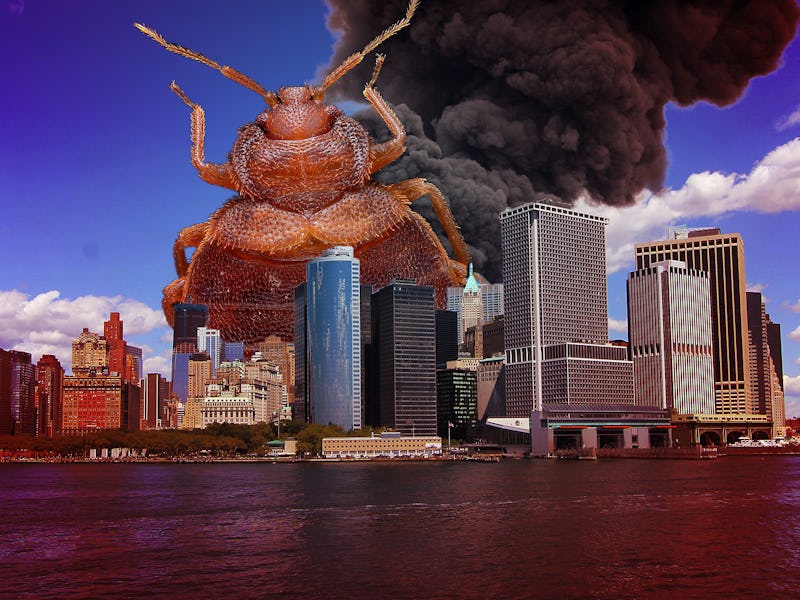Scientists Found that Some Bed Bugs Can Escape Traps
Just when you thought bed bugs couldn't get any creepier.

Burrowing into skin, laying eggs in mattresses, and building entire colonies in sofas, bed bugs are any city dweller’s worst nightmare.
That nightmare just got worse: A study published in the Journal of Economic Entomology found that one species of bed bug can crawl out of any trap you lay before it.
The rogue bed bug, Cimex hemipterus, loves tropical ecosystems, and has been found in the southern U.S., China, Japan, Taiwan, Africa, and Australia. Unfortunately, they are spreading to more moderate climates across the globe.
According to Chow-Yang Lee, co-author of the research and professor at the University of Science Malaysia, exactly how they are spreading is unknown. Climate change could be a factor — with less harsh winters, they can survive and reproduce more readily in the spring. But travel plays the likelier culprit.
“The tropical bed bug infestation was found in an apartment in Norway, whose owner returned from Thailand several months back,” Lee tells Inverse. “During winter, most indoor environments are heated and hence it is certainly possible for tropical bed bugs to thrive.”
The researchers found that Cimex hemipterus are able to scale up smooth surfaces — including traps traditionally designed to lure them in. The experiment started at the University of Science Malaysia, where scientists set up four different contraptions and put five females, five males, and five nymphs of Cimex hemipterus and another species, Cimex lectularius, inside. They then watched them over a ten-day period. All the adult Cimex hemipterus escaped each of the four traps effortlessly, while the Cimex lectularius struggled to escape any of them. They repeated the experiment three times and every time, every adult Cimex hemipterus escaped.
The two images compare the hemipterus (B) to another species called the lectularius (A), showing that the hemipterus has many more hairs surrounding its foot.
Like cockroaches, beetles, and flies, Cimex hemipterus have little pads on their feet. When put under a microscope, scientists found that Cimex hemipterus have more hairs surrounding the pads than other species of bed bugs. Upon further investigation, the scientists found that the hairs — called tenent hairs, and not to be confused with tenants in an apartment — seem to be hollow and connected to a gland that could secrete some kind of sticky ooze to help them escape traps. “But, at this stage, we are unable to prove that the tenent hairs were producing secretion that help them stick better,” Lee says.
Just what gives the Cimex hemipterus its evolutionary advantage is still to be determined. After looking into their history, the team believes they may have ancestral ties to a species found in Papua New Guinea in 1932, which also had the pads. Lee believes the bugs develop the hairs in adulthood, because nymphs were unable to escape most of the traps. “We [need to] try to understand the role of tenent hairs in adult bed bugs, which we suspected is related with mating behavior,” he surmises.
This means it’s high time to reconsider bed bug trap design. Lee suggests a hydrophobic plastron surface, which would repel the little monsters (maybe ion mobility spectrometry could work?). These solutions are in the early stages of production. Until then, though, it’s fair to warn city people that warm apartments make for a cozy environment for both cold residents and mutant bed bugs alike.
Abstract
The climbing abilities of two bed bug species, Cimex lectularius L. and Cimex hemipterus (F.), were determined by evaluating their escape rates from smooth surface pitfall traps using four commercial bed bug monitors (Verifi Bed Bug Detector, ClimbUp Insect Interceptor, BlackOut Bed Bug Detector, and SenSci Volcano Bed Bug Detector). All detectors were used in the absence of lures or attractants. Unlike C. lectularius, adult C. hemipte-rus were able to escape from all traps. On the other hand, no or a low number nymphs of both species escaped, depending on the evaluated traps. Examination of the vertical friction force of adults of both species revealed a higher vertical friction force in C. hemipterus than in C. lectularius. Scanning electron microscope micrograph observation on the tibial pad of adult bed bugs of C. hemipterus showed the presence of a greater number of tenent hairs on the tibial pad than on that of adult C. lectularius. No tibial pad was found on the fourth and fifth instars of both species. Near the base of the hollow tenent hairs is a glandular epithelium that is better developed in adult C. hemipterus than in adult C. lectularius. This study highlights significant morphological differences between C. lectularius and C. hemipterus, which may have implications in the monitoring and management of bed bug infestations.